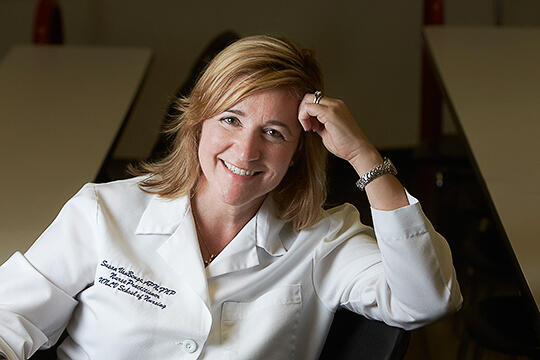People often face multiple chronic ailments during their senior years, clusters of conditions that demand a collaborative approach to treatment. But today there are few, if any, training opportunities aimed at preparing the next generation of practitioners and specialists for the challenges of providing the collaborative, interprofessional elder care that is so desperately needed.
Susan VanBeuge is changing that.
VanBeuge is an assistant professor in the School of Nursing who is co-principal investigator with Georgia Dounis, an associate professor of clinical sciences in UNLV's School of Dental Medicine, and Sue Schuerman, an assistant professor in the School of Allied Health Sciences. The UNLV team is a sub-awardee of the Nevada Geriatric Education Consortium, a statewide initiative aimed at improving the health care delivered to older adults.
The UNLV objectives include developing a Type 2 diabetes management training program for interprofessional faculty with emphasis on communication, prevention of co-morbidities, and cultural sensitivity.
At its core, VanBeuge's program aims to develop a series of provider training for senior health issues to include Type 2 diabetes and Alzheimer's disease. The UNLV team, for example, has developed a one-day training program focused on Type 2 diabetes and offered it statewide to health care providers and faculty who work with professional students. The program includes video-recorded encounters with "standardized" patients -- individuals trained to simulate the needs of real patients -- and hands-on training with high-fidelity manikins.
The program focused on Type 2 diabetes because of its multiple symptoms, prevalence among older adults, and the need for multiple health care professionals to involve themselves in treatment and management of the condition.
During the training, each participant received a chart detailing a standardized patient's medical and social history, physical attributes, clinical findings, and chief complaint. Teams had 15 minutes to complete the examination. During the encounter, each group assessed their patient's physical status, formulated treatment goals and intervention options, noted potential outcomes, and identified opportunities for coordination of care. They also developed a plan for how responsibility for that care would transpire.
The teams next participated in a debriefing session with the project's instructors (who were observing the interactions in real time on video monitors). Finally, instructors led a group discussion and encouraged self-assessments from participants.
Thus far, the five-year grant, now in its fourth year, has seen close to 100 participants complete the course. Early findings were published after the study's second year. Participants at that time told the researchers that they had gained a better understanding of inter-professional team building, a stronger ability to communicate effectively with team members, and greater confidence in recognizing that meeting the needs of geriatric patients often requires an interprofessional response.
The project has been featured in the Journal of Interdisciplinary Healthcare and has been presented during multiple national clinical conferences. The team recently received additional funding to include Alzheimer's disease and dementia to the course training for the coming year.



